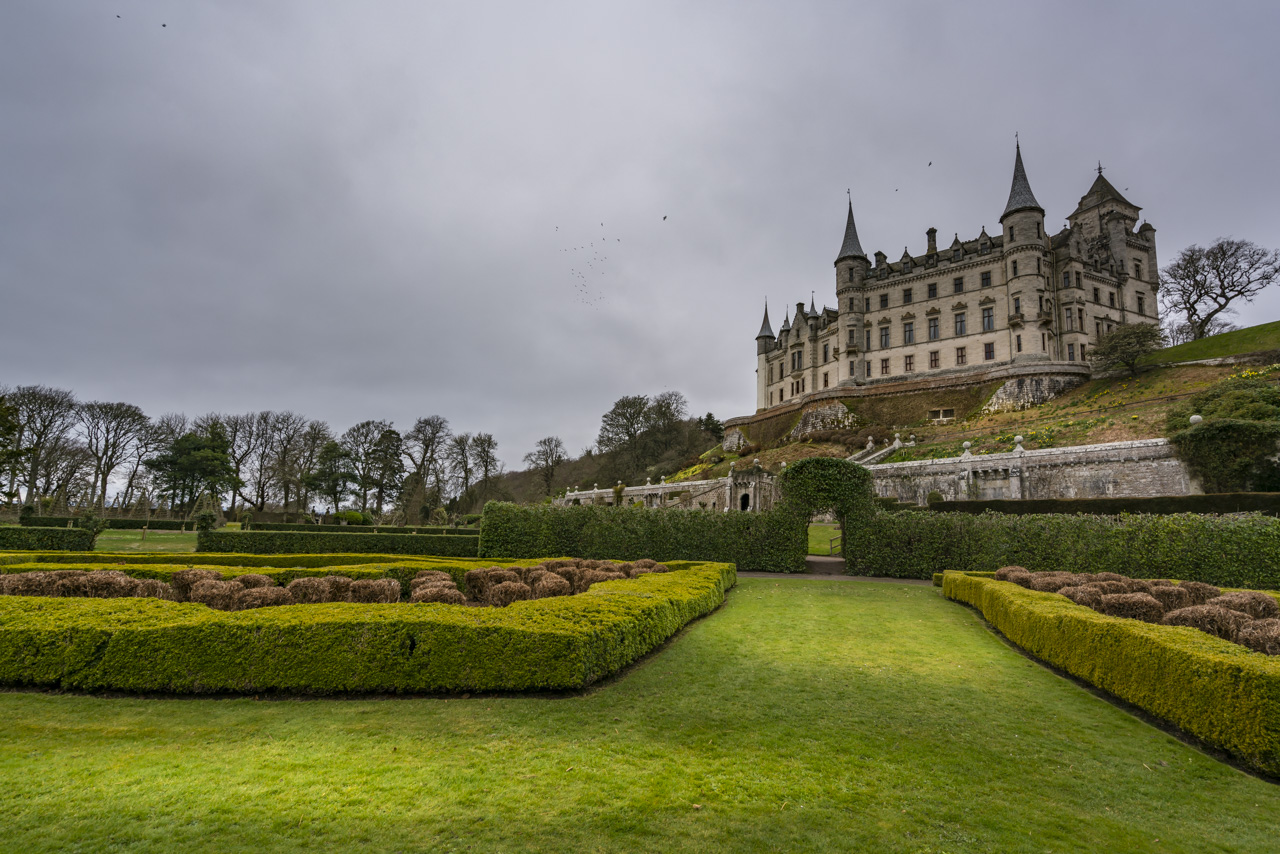Highlights of Dunrobin Castle
Are you thinking of driving the North Coast 500? Make sure to add Dunrobin Castle to your itinerary.
The Scottish Highlands are home to arguably one of the most dramatic coastlines in the world, along with rich history and epic battles. Driving through the region, you feel a world away from the frenzied urban energy of Edinburgh. Quaint fishing villages, cafes, and dramatic castles make the highlands a stunning getaway.
Dunrobin Castle: What’s it all about?
Dunrobin Castle is a quintessential romantic castle and the ancestral home of the Earls and Dukes of Sutherland. It’s a castle that feels like it ought to belong in a fairytale and a must-see for anyone traveling through the highlands. Located on the east coast of the northern highlands, just north of Golspie and Dornoch villages, it is one of the largest in northern Scotland.
Resembling a French chateau with dramatic conical spires, it majestically overlooks the sea. Dunrobin is undoubtedly a wonderful way to experience old Scotland!
Inside the Castle
The castle features an impressive 189 rooms, all decorated extravagantly and perfectly preserved. Visitors can enjoy fabulous views of the sea and the surrounding gardens.
A stroll through the gardens is spectacular, especially with falcons soaring above, thanks to a daily falconry display—the only one of its kind in the region!
What makes Dunrobin so special is the way you can walk through it and the surrounding gardens without feeling like you’re visiting a museum. The lavish rooms feel authentic and welcoming rather than contrived. Information is readily available to visitors, and the grounds are well-maintained and stunning.
The entire property evokes the allure of a Scottish Disney Castle.
The History of Dunrobin Castle
Dunrobin Castle and the Middle Ages:
Dating back to the Middle Ages (circa the 1300s), Dunrobin Castle is one of the oldest continuously inhabited houses in Scotland. It has been home to the Earls and Dukes of Sutherland and was later used as a boarding school.
The building has undergone several changes, including remodeling by famous architect Sir Charles Barry, although a portion of the original structure remains visible from the interior courtyard.
Ownership has passed through various Sutherland royals who added their unique flair, protections, and expansions through a series of renovations. The oldest part, the tower-keep, still features vaulted ceilings on every floor, with walls two meters thick!
WW1 to Present Day
During World War I, the castle served as a naval hospital and later endured a fire that damaged a significant part of its interior. The main tower and clock tower were renovated to reflect a Scottish Renaissance style. Before opening to the public in 1973, the castle functioned as a boys boarding school from 1965 to 1972.
The Sutherland family retains a private area of the house, which is not open to the public. Be sure to look for the carved cat gargoyles atop the castle’s windows, representing the Scottish family crest featuring a wildcat.
What to Expect at Dunrobin Castle
Upon arrival, both group and self-guided tours are available, although self-guided tours are encouraged, as castle guides are present in the main rooms to answer any questions. Most of the castle grounds are accessible to the public, except for the Sutherland family private area.
Visitors may tour about 20 of the castle’s 189 rooms, including the drawing-room, library, study, bedrooms, and nurseries. While it may seem limiting, each room has its own unique flair, showcasing a variety of paintings, portraits, and collections of furniture, photographs, artwork, uniforms, china, and family memorabilia.
Dunrobin’s architecture is heavily influenced by French styles, and the gardens are modeled after the Garden of Versailles—making the resemblance uncanny. From the terrace, you will enjoy spectacular 360-degree views of the property and the sea.
Tips for Visiting Dunrobin Castle
Visiting Dunrobin Castle feels like stepping into a Scottish interpretation of Disney Castle; come prepared to immerse yourself in this magical enclave nestled in the northern highlands.
Unfortunately, photos are not permitted inside, which can be disappointing. However, this encourages a more immersive experience. Save your photography for the gardens and stunning exterior shots of the castle perched on the hill.
Don’t miss the falconry display in the garden. Typically, an employee provides an overview of the display and insights about falcons, except on Sundays. If you are lucky, you may even have the chance to have a bird of prey land and take off from your wrist!
A small museum located at the edge of the grounds features historic artifacts including spearheads and Pictish stones from the area, along with taxidermy collected by past castle inhabitants. After your visit, you can stop by the gift shop and enjoy light meals and snacks at the castle tea room.
Base Yourself at One of These Great Hotels
Dornoch Castle Hotel – We stayed at this 3 Star Hotel and loved it. Quaint rooms with great views and an incredible selection of Single Malt Scotch in the bar make it perfect for history buffs and whiskey lovers.
View Rates on Tripadvisor / Check Availability on Booking.com
Royal Marine Hotel – If you are seeking 4-star luxury, this hotel offers stunning views and beautiful rooms on a golf course, including breakfast!
View Rates on Tripadvisor / Check Availability on Booking.com
Allocate at least a couple of hours for your visit to Dunrobin, as there is much to see beyond the interior rooms. Take your time to soak in the atmosphere of this magical and haunting place, enriched by its dense and fated past.
Photos in this article are credited to Dave Bouskill.





